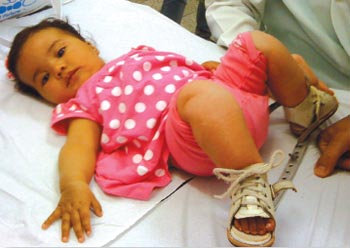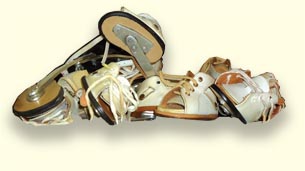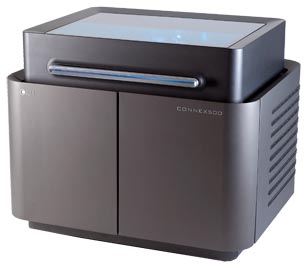miraclefeet and Objet Bring Innovation to Braces
Objet Geometries helps design a better fit for children needing clubfoot braces all over the world.
Latest News
April 1, 2011
By Susan Smith
 A baby in Botucatu, Brazil, who is in the old brace 23 hours a day. She will soon switch to nights only. |
Most of us take for granted that children with certain birth defects can be helped by surgery or corrective intervention. Thus, we never see children with cleft palates or clubfeet beyond babyhood today.
For children in developing nations, however, this is not a given. Children with a clubfoot, or congenital talipes equinovarus (CTEV), cannot walk and cannot go to school. They may be hidden away because their families are embarrassed by their condition. Subsequently, there is a high incidence of abuse and abandonment among these children.
The inability to walk presents a severe disability in developing countries because there are no school buses to deliver children to school, no wheelchairs are readily available.
So why are children in developing countries not getting treatment? The reason: The current method of correcting a clubfoot is for the foot to be casted, and then placed in a brace for a period of time. The cost of the braces can be prohibitive—around $1,600 in countries where wages are often as low as $2 per day. Moreover, the braces are uncomfortable and hard to put on. The children don’t like to wear them, and parents don’t like to put them on.
In 2010, Objet Geometries was approached by the non-profit organization miraclefeet and Dr. Mike North, North Design Labs (and of the former “Prototype This!” Discovery Channel TV series), to help design a more affordable, comfortable brace for children with clubfoot, their focus being on those children in developing nations.
 |
Effective Treatment
In the 1950s, the cast-brace treatment was developed at the University of Iowa by Dr. Ignacio Ponseti as an alternative to surgery, which had limited success. Ponseti found that clubfoot could be treated much more effectively by casting. By gently manipulating the ligaments and tendons in the foot, then putting a cast on, after five to seven days, the cast comes off and the foot has moved 10 to 15 degrees.
“You do it five times, and generally in 95% of cases the foot is fully corrected,” explains miraclefeet Managing Director Chesca Colloredo-Mansfeld. “So suddenly, you have this treatment that is cheap, easy to do, non-invasive, not dangerous, and it’s very easy to teach.”
At that point, the foot is fully corrected. In the U.S. this is done when the child is about two weeks old. By two months, the infant has done eight casts.
“The problem is, you haven’t cured clubfoot, you have corrected it,” Colloredo-Mansfeld says. “Because of its genetic component, each time the child grows, the foot tries to grow back to that position. So to fix that problem, the child wears a brace—typically, a Mitchell brace.”
However, compliance rates in other countries are much lower, resulting in relapses—many of which are never treated. Distance and lack of education and information are factors, but the expense, lack of comfort and ease of use of the locally made braces are huge contributors.
 Objet’s multi-material 3D printer, on which the miraclefeet brace prototype is being printed. |
For example, Mexico’s most experienced Ponseti doctor who works in a large public hospital in Guadalajara has a 50% dropout rate during the bracing phase of treatment.
A Better Brace
Objet U.S. President Frank Marangell and Director of Marketing Bruce Bradshaw note that the Objet Connex 3D multi-material printer is a good fit for miraclefeet because of its multiple and flexible material technology.
“With Connex, we have the ability to prototype rigid and soft parts—essentially 11 different mechanical properties, depending upon the type of material you use in the same part,” says Marangell. “This provides the folks making miraclefeet a unique way of really identifying the attributes they want to bring to market, making sure the cost for this is significantly reduced over what it costs today.”
What miraclefeet and North are trying to develop is a product that:
- is much more natural;
- has soft edges;
- connects to any shoe; and
- is expandable so that it will last a little longer than two years.
The profits miraclefeet makes go toward bringing this design and this device to developing countries, “so it’s a non-profit organization working to provide something that Third World countries can’t even touch at $1,600 price points,” says Marangell.
The design aims to offer a more comfortable brace for children. “They were able to use the Connex technology to vary the derometer of the component that connects to the shoe,” says Bradshaw.
The Connex machine allows the user to print 11 different derometers, which is like printing 11 different materials at the same time. Choices range from a rigid and a very soft rubber,with 11 different flexibilities in-between those textures.
“That allows them to actually help the design before it goes to final production by choosing one of the different rubbers, and deciding whether they are too rigid,” says Marangell. “You can print another one in the next revision of the prototype before you actually go to production of this product. You can build all of that in the same prints.”
He added that the machine allows the user to print moving hinges, the rigid parts and all the different soft materials at the same time, “and it allows the prototype to mirror perfectly the end product. The result is that you get a better end product, because it really allows you to do many revisions.”
For the brace, Objet prototypes will be used primarily for the bar and the footbed.
“Depending on the size of the parts they are actually testing, they can print on Connex 500 two or three of these all at the same time, all with different mechanical properties, so they could print three of them that have different flexibilities all at the same time, and try them on the child, and ask him or her ‘Which one feels best to you?’” says Bradshaw. “They may not know early on what the best fit is, but the fact that they can print three at the same time—or more—means they can narrow down their choices and find out what is the best material very early on in the design process, long before production.”
Bradshaw points out that typically Objet is in the business of selling equipment for people to do designs, and not very involved in the design process itself. With this project, he says, it is “exciting working with Dr. North, as he is working with visionaries and designers all over the country, collaborating to find out just what is the best design.”
“The fact that they can print a part and have it in their hands very easily allowed them to visualize where this project should go,” he adds. “It has really helped when miraclefeet have their board meetings to be able to show members an actual prototype.”
The two base materials used for the prototype are Vero White, a rigid component, and Tango Black Plus, a black, rubber-like flexible material. “It takes combinations of those two materials to come up with the different mechanical properties that you select for the parts,” Bradshaw says.
At press time, the prototype is still in development as miraclefeet works to get the brace into an aesthetically pleasing and manufacturable state. North favors materials that can be washed off easily under the kitchen tap or a standpipe in the street. The braces will perhaps have hook-and-loop strips rather than the laces, and possibly breathable silicone or foam that wraps the foot. The bar will be made of injection-molded plastic instead of metal.
miraclefeet is considering producing the braces in different colors and with soccer team logos so they have more appeal to children.
More Info:
Objet Geometries
miraclefeet
North Design Labs
Ponseti International
Bringing the Brace to the World Brazilian doctors say the biggest deterrent to treatment is the brace itself. There are a number of reasons why, says Colloredo-Mansfeld. “First, it’s very expensive—they are usually about $350, and in the U.S., generally it’s covered by insurance, and people just pay it,” she says. “But you also need multiple braces. As the kid grows, you need another one, etc. You need more shoes, so it’s a very expensive little piece of equipment in developing countries.” Brazil’s public health system only covers a cheap brace that doesn’t seem to work, so few of the doctors will use it. These braces are little leather boots with difficult-to-use laces that attach to a metal bar. They are difficult to put on, and when they are recycled, the leather gets hard and crunchy and rubs against the skin. “miraclefeet is making a new brace that is more affordable, easier to use, more comfortable, and more kid-friendly. Each of these factors increases the likelihood that a child will wear the brace, and hence, make successful treatment more likely,” says Colloredo-Mansfeld. The brace is a piece of metal with shoes attached that stretches all the tendons, particularly the Achilles tendon, and keeps the feet pointing in the right direction. The child wears the brace for three months after treatment full-time, and he or she only takes it off to bathe. Once the child is through that three-month period, her or she wears it only at night for the next four years. “Because the child goes through big growth spurts, in some cases, there will be some relapses later on and they may have to go back to wearing the braces, but generally the older the child gets, the less they will need the brace,” says Colloredo-Mansfeld. “You can do the casting also for older kids who will not need to wear the brace. Then, of course, you’ve lost five years of development, and you don’t want that to happen if possible.” Although Dr. Ignacio Ponseti did not think of treating older children in this way, Brazilian doctors have found that they can treat children up to the age of 16 with remarkable results. Other older children adopted from China or Russia and brought to the U.S. have also enjoyed good results from treatment. “What is critical for our long-term success is to develop a low-cost, easy-to-use brace for the developing world,” Colloredo-Mansfeld says. “We want to create a brace in the $25 range, as opposed to the $300 range in the U.S. or the $100 range in Brazil, and we’re going to be using materials that make it much easier for the parents to use.” The braces will be made in a number of sizes, and children will not need as many sizes, because the footbed of the newly designed brace will be more flexible. “We provide the braces for all the doctors we’re working with,” says Colloredo-Mansfeld. “We have a model where we partner with local doctors in the countries we’re working in, so we find a Brazilian doctor who is trained in the Ponseti method and we’ll partner with his or her hospital. Then we provide them with grants based on how many additional children they can treat.” An example is a university hospital in Sao Paolo where they could treat an additional 20 kids—and so have increased the number to 60 kids. “We give them $200 for each child. Now they spend $150 on a brace and they recycle them,” says Colloredo-Mansfeld. “This way they will be able to provide a lending library of braces in different sizes. In some cases parents will want to buy them, and at $20 they will be much more affordable.” |
Contributing Editor Susan Smith has written and edited for various publications in the tech industry for more than 17 years. Send e-mail about this article to [email protected].
Subscribe to our FREE magazine, FREE email newsletters or both!
Latest News
About the Author
DE’s editors contribute news and new product announcements to Digital Engineering.
Press releases may be sent to them via [email protected].






